Analyzing Balance Scorecard Implementation for Sheffield Surgical Ltd
VerifiedAdded on 2019/10/08
|7
|2311
|338
Report
AI Summary
This report focuses on Sheffield Surgical Ltd (SSL), a manufacturer of surgical instruments facing stagnant sales and increasing costs. The study proposes the implementation of a Balance Scorecard to improve performance. The report explains the concept of the Balance Scorecard, its four perspectives (financial, customer, internal processes, and innovation), and how it can be introduced at SSL. It highlights the benefits, such as improved performance monitoring and strategic alignment, and discusses potential drawbacks like cost and time consumption. The report also delves into the specific aspects of the Balance Scorecard relevant to SSL, including financial stability, customer satisfaction, innovation, and internal processes. The conclusion emphasizes the importance of the Balance Scorecard in revitalizing SSL's sales and achieving its business goals.
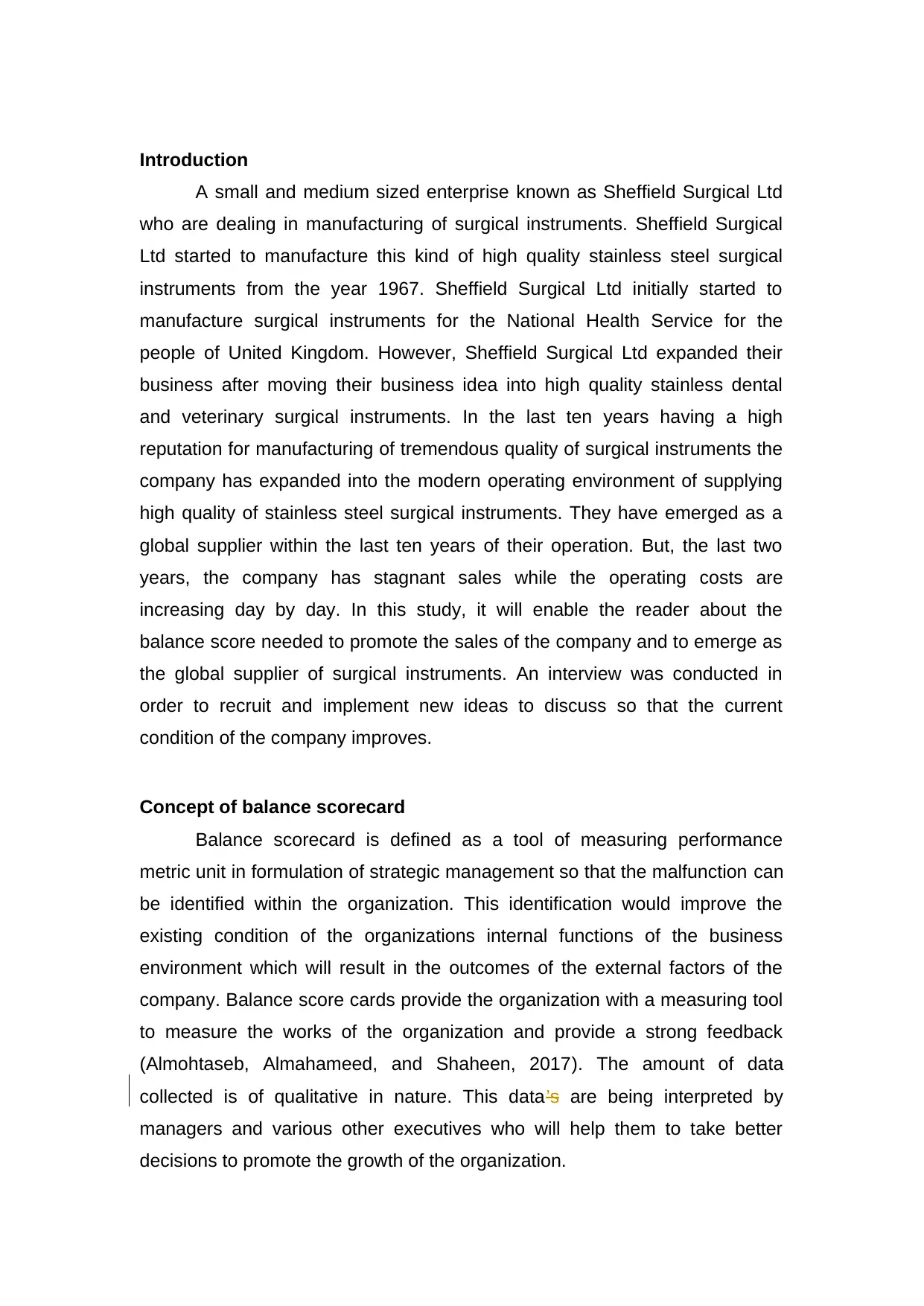
Introduction
A small and medium sized enterprise known as Sheffield Surgical Ltd
who are dealing in manufacturing of surgical instruments. Sheffield Surgical
Ltd started to manufacture this kind of high quality stainless steel surgical
instruments from the year 1967. Sheffield Surgical Ltd initially started to
manufacture surgical instruments for the National Health Service for the
people of United Kingdom. However, Sheffield Surgical Ltd expanded their
business after moving their business idea into high quality stainless dental
and veterinary surgical instruments. In the last ten years having a high
reputation for manufacturing of tremendous quality of surgical instruments the
company has expanded into the modern operating environment of supplying
high quality of stainless steel surgical instruments. They have emerged as a
global supplier within the last ten years of their operation. But, the last two
years, the company has stagnant sales while the operating costs are
increasing day by day. In this study, it will enable the reader about the
balance score needed to promote the sales of the company and to emerge as
the global supplier of surgical instruments. An interview was conducted in
order to recruit and implement new ideas to discuss so that the current
condition of the company improves.
Concept of balance scorecard
Balance scorecard is defined as a tool of measuring performance
metric unit in formulation of strategic management so that the malfunction can
be identified within the organization. This identification would improve the
existing condition of the organizations internal functions of the business
environment which will result in the outcomes of the external factors of the
company. Balance score cards provide the organization with a measuring tool
to measure the works of the organization and provide a strong feedback
(Almohtaseb, Almahameed, and Shaheen, 2017). The amount of data
collected is of qualitative in nature. This data’s are being interpreted by
managers and various other executives who will help them to take better
decisions to promote the growth of the organization.
A small and medium sized enterprise known as Sheffield Surgical Ltd
who are dealing in manufacturing of surgical instruments. Sheffield Surgical
Ltd started to manufacture this kind of high quality stainless steel surgical
instruments from the year 1967. Sheffield Surgical Ltd initially started to
manufacture surgical instruments for the National Health Service for the
people of United Kingdom. However, Sheffield Surgical Ltd expanded their
business after moving their business idea into high quality stainless dental
and veterinary surgical instruments. In the last ten years having a high
reputation for manufacturing of tremendous quality of surgical instruments the
company has expanded into the modern operating environment of supplying
high quality of stainless steel surgical instruments. They have emerged as a
global supplier within the last ten years of their operation. But, the last two
years, the company has stagnant sales while the operating costs are
increasing day by day. In this study, it will enable the reader about the
balance score needed to promote the sales of the company and to emerge as
the global supplier of surgical instruments. An interview was conducted in
order to recruit and implement new ideas to discuss so that the current
condition of the company improves.
Concept of balance scorecard
Balance scorecard is defined as a tool of measuring performance
metric unit in formulation of strategic management so that the malfunction can
be identified within the organization. This identification would improve the
existing condition of the organizations internal functions of the business
environment which will result in the outcomes of the external factors of the
company. Balance score cards provide the organization with a measuring tool
to measure the works of the organization and provide a strong feedback
(Almohtaseb, Almahameed, and Shaheen, 2017). The amount of data
collected is of qualitative in nature. This data’s are being interpreted by
managers and various other executives who will help them to take better
decisions to promote the growth of the organization.
Paraphrase This Document
Need a fresh take? Get an instant paraphrase of this document with our AI Paraphraser
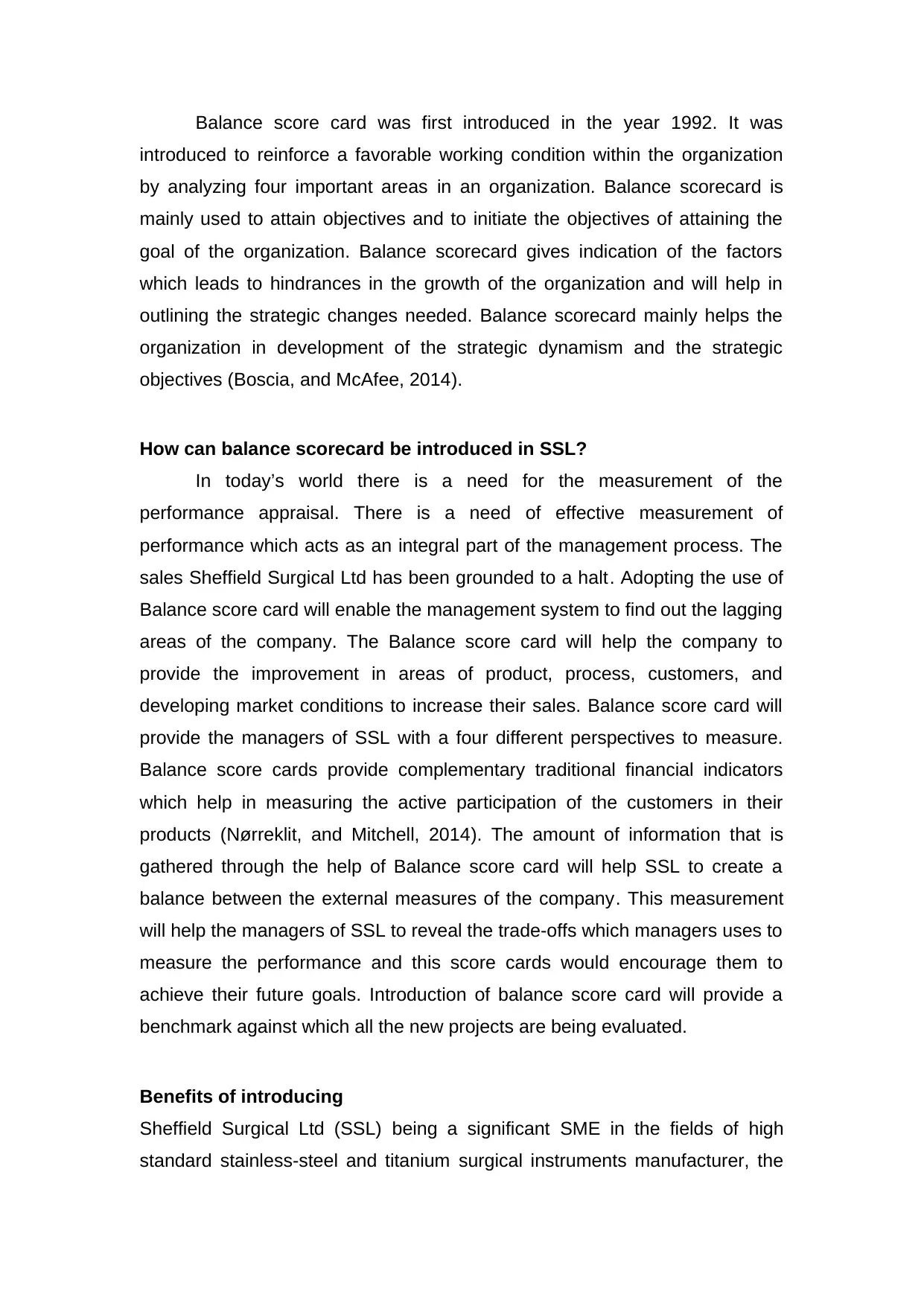
Balance score card was first introduced in the year 1992. It was
introduced to reinforce a favorable working condition within the organization
by analyzing four important areas in an organization. Balance scorecard is
mainly used to attain objectives and to initiate the objectives of attaining the
goal of the organization. Balance scorecard gives indication of the factors
which leads to hindrances in the growth of the organization and will help in
outlining the strategic changes needed. Balance scorecard mainly helps the
organization in development of the strategic dynamism and the strategic
objectives (Boscia, and McAfee, 2014).
How can balance scorecard be introduced in SSL?
In today’s world there is a need for the measurement of the
performance appraisal. There is a need of effective measurement of
performance which acts as an integral part of the management process. The
sales Sheffield Surgical Ltd has been grounded to a halt. Adopting the use of
Balance score card will enable the management system to find out the lagging
areas of the company. The Balance score card will help the company to
provide the improvement in areas of product, process, customers, and
developing market conditions to increase their sales. Balance score card will
provide the managers of SSL with a four different perspectives to measure.
Balance score cards provide complementary traditional financial indicators
which help in measuring the active participation of the customers in their
products (Nørreklit, and Mitchell, 2014). The amount of information that is
gathered through the help of Balance score card will help SSL to create a
balance between the external measures of the company. This measurement
will help the managers of SSL to reveal the trade-offs which managers uses to
measure the performance and this score cards would encourage them to
achieve their future goals. Introduction of balance score card will provide a
benchmark against which all the new projects are being evaluated.
Benefits of introducing
Sheffield Surgical Ltd (SSL) being a significant SME in the fields of high
standard stainless-steel and titanium surgical instruments manufacturer, the
introduced to reinforce a favorable working condition within the organization
by analyzing four important areas in an organization. Balance scorecard is
mainly used to attain objectives and to initiate the objectives of attaining the
goal of the organization. Balance scorecard gives indication of the factors
which leads to hindrances in the growth of the organization and will help in
outlining the strategic changes needed. Balance scorecard mainly helps the
organization in development of the strategic dynamism and the strategic
objectives (Boscia, and McAfee, 2014).
How can balance scorecard be introduced in SSL?
In today’s world there is a need for the measurement of the
performance appraisal. There is a need of effective measurement of
performance which acts as an integral part of the management process. The
sales Sheffield Surgical Ltd has been grounded to a halt. Adopting the use of
Balance score card will enable the management system to find out the lagging
areas of the company. The Balance score card will help the company to
provide the improvement in areas of product, process, customers, and
developing market conditions to increase their sales. Balance score card will
provide the managers of SSL with a four different perspectives to measure.
Balance score cards provide complementary traditional financial indicators
which help in measuring the active participation of the customers in their
products (Nørreklit, and Mitchell, 2014). The amount of information that is
gathered through the help of Balance score card will help SSL to create a
balance between the external measures of the company. This measurement
will help the managers of SSL to reveal the trade-offs which managers uses to
measure the performance and this score cards would encourage them to
achieve their future goals. Introduction of balance score card will provide a
benchmark against which all the new projects are being evaluated.
Benefits of introducing
Sheffield Surgical Ltd (SSL) being a significant SME in the fields of high
standard stainless-steel and titanium surgical instruments manufacturer, the
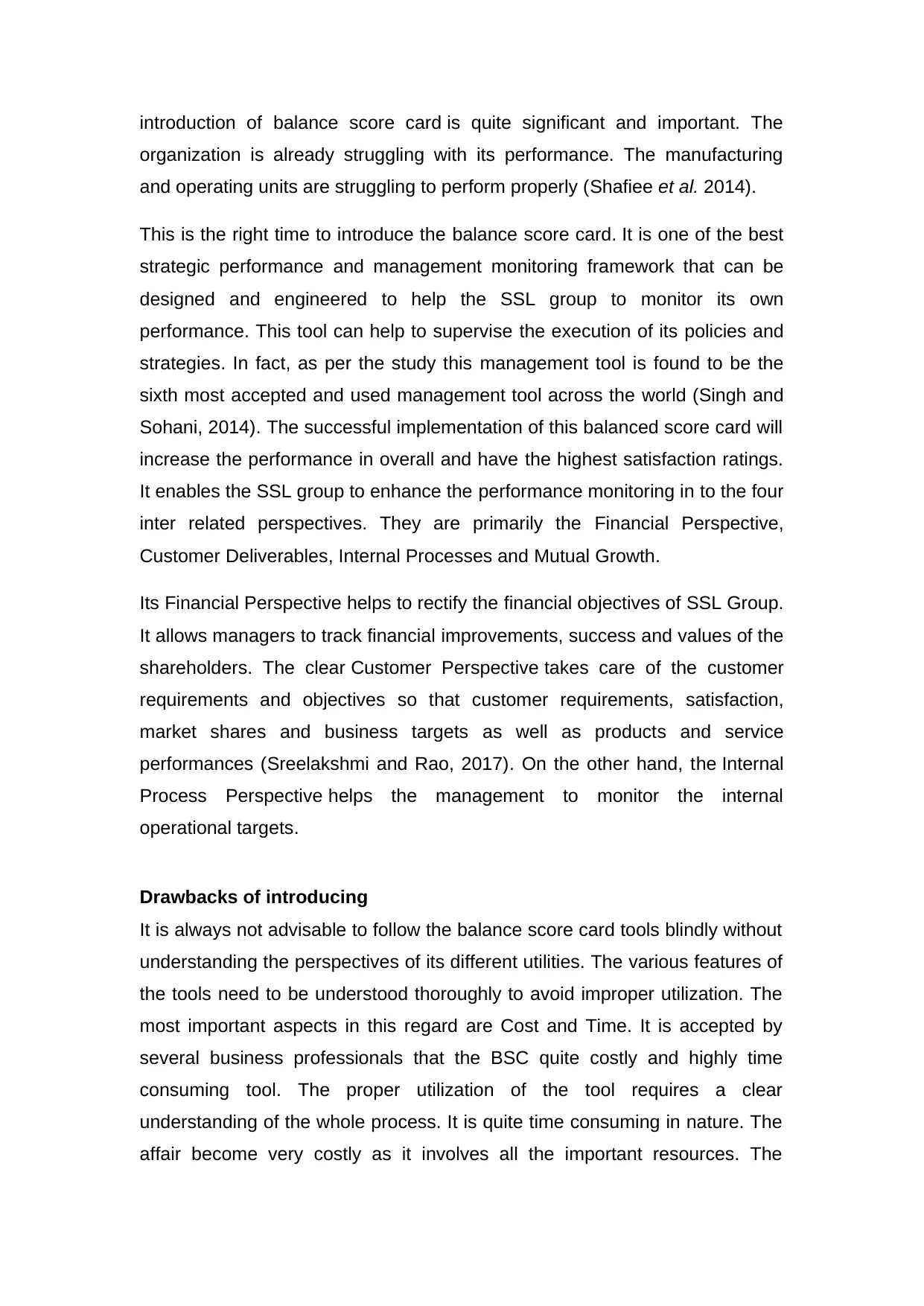
introduction of balance score card is quite significant and important. The
organization is already struggling with its performance. The manufacturing
and operating units are struggling to perform properly (Shafiee et al. 2014).
This is the right time to introduce the balance score card. It is one of the best
strategic performance and management monitoring framework that can be
designed and engineered to help the SSL group to monitor its own
performance. This tool can help to supervise the execution of its policies and
strategies. In fact, as per the study this management tool is found to be the
sixth most accepted and used management tool across the world (Singh and
Sohani, 2014). The successful implementation of this balanced score card will
increase the performance in overall and have the highest satisfaction ratings.
It enables the SSL group to enhance the performance monitoring in to the four
inter related perspectives. They are primarily the Financial Perspective,
Customer Deliverables, Internal Processes and Mutual Growth.
Its Financial Perspective helps to rectify the financial objectives of SSL Group.
It allows managers to track financial improvements, success and values of the
shareholders. The clear Customer Perspective takes care of the customer
requirements and objectives so that customer requirements, satisfaction,
market shares and business targets as well as products and service
performances (Sreelakshmi and Rao, 2017). On the other hand, the Internal
Process Perspective helps the management to monitor the internal
operational targets.
Drawbacks of introducing
It is always not advisable to follow the balance score card tools blindly without
understanding the perspectives of its different utilities. The various features of
the tools need to be understood thoroughly to avoid improper utilization. The
most important aspects in this regard are Cost and Time. It is accepted by
several business professionals that the BSC quite costly and highly time
consuming tool. The proper utilization of the tool requires a clear
understanding of the whole process. It is quite time consuming in nature. The
affair become very costly as it involves all the important resources. The
organization is already struggling with its performance. The manufacturing
and operating units are struggling to perform properly (Shafiee et al. 2014).
This is the right time to introduce the balance score card. It is one of the best
strategic performance and management monitoring framework that can be
designed and engineered to help the SSL group to monitor its own
performance. This tool can help to supervise the execution of its policies and
strategies. In fact, as per the study this management tool is found to be the
sixth most accepted and used management tool across the world (Singh and
Sohani, 2014). The successful implementation of this balanced score card will
increase the performance in overall and have the highest satisfaction ratings.
It enables the SSL group to enhance the performance monitoring in to the four
inter related perspectives. They are primarily the Financial Perspective,
Customer Deliverables, Internal Processes and Mutual Growth.
Its Financial Perspective helps to rectify the financial objectives of SSL Group.
It allows managers to track financial improvements, success and values of the
shareholders. The clear Customer Perspective takes care of the customer
requirements and objectives so that customer requirements, satisfaction,
market shares and business targets as well as products and service
performances (Sreelakshmi and Rao, 2017). On the other hand, the Internal
Process Perspective helps the management to monitor the internal
operational targets.
Drawbacks of introducing
It is always not advisable to follow the balance score card tools blindly without
understanding the perspectives of its different utilities. The various features of
the tools need to be understood thoroughly to avoid improper utilization. The
most important aspects in this regard are Cost and Time. It is accepted by
several business professionals that the BSC quite costly and highly time
consuming tool. The proper utilization of the tool requires a clear
understanding of the whole process. It is quite time consuming in nature. The
affair become very costly as it involves all the important resources. The
⊘ This is a preview!⊘
Do you want full access?
Subscribe today to unlock all pages.

Trusted by 1+ million students worldwide
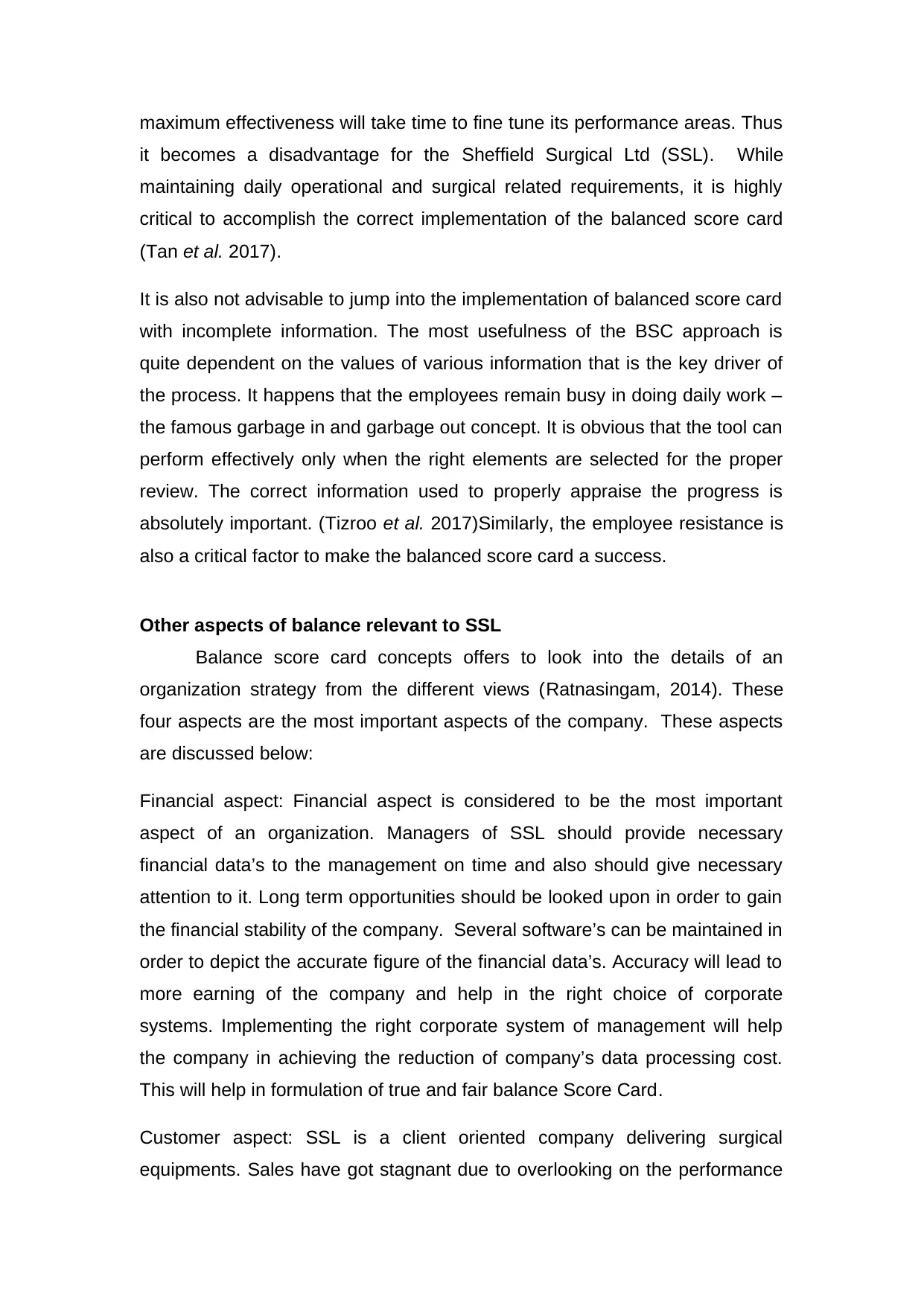
maximum effectiveness will take time to fine tune its performance areas. Thus
it becomes a disadvantage for the Sheffield Surgical Ltd (SSL). While
maintaining daily operational and surgical related requirements, it is highly
critical to accomplish the correct implementation of the balanced score card
(Tan et al. 2017).
It is also not advisable to jump into the implementation of balanced score card
with incomplete information. The most usefulness of the BSC approach is
quite dependent on the values of various information that is the key driver of
the process. It happens that the employees remain busy in doing daily work –
the famous garbage in and garbage out concept. It is obvious that the tool can
perform effectively only when the right elements are selected for the proper
review. The correct information used to properly appraise the progress is
absolutely important. (Tizroo et al. 2017)Similarly, the employee resistance is
also a critical factor to make the balanced score card a success.
Other aspects of balance relevant to SSL
Balance score card concepts offers to look into the details of an
organization strategy from the different views (Ratnasingam, 2014). These
four aspects are the most important aspects of the company. These aspects
are discussed below:
Financial aspect: Financial aspect is considered to be the most important
aspect of an organization. Managers of SSL should provide necessary
financial data’s to the management on time and also should give necessary
attention to it. Long term opportunities should be looked upon in order to gain
the financial stability of the company. Several software’s can be maintained in
order to depict the accurate figure of the financial data’s. Accuracy will lead to
more earning of the company and help in the right choice of corporate
systems. Implementing the right corporate system of management will help
the company in achieving the reduction of company’s data processing cost.
This will help in formulation of true and fair balance Score Card.
Customer aspect: SSL is a client oriented company delivering surgical
equipments. Sales have got stagnant due to overlooking on the performance
it becomes a disadvantage for the Sheffield Surgical Ltd (SSL). While
maintaining daily operational and surgical related requirements, it is highly
critical to accomplish the correct implementation of the balanced score card
(Tan et al. 2017).
It is also not advisable to jump into the implementation of balanced score card
with incomplete information. The most usefulness of the BSC approach is
quite dependent on the values of various information that is the key driver of
the process. It happens that the employees remain busy in doing daily work –
the famous garbage in and garbage out concept. It is obvious that the tool can
perform effectively only when the right elements are selected for the proper
review. The correct information used to properly appraise the progress is
absolutely important. (Tizroo et al. 2017)Similarly, the employee resistance is
also a critical factor to make the balanced score card a success.
Other aspects of balance relevant to SSL
Balance score card concepts offers to look into the details of an
organization strategy from the different views (Ratnasingam, 2014). These
four aspects are the most important aspects of the company. These aspects
are discussed below:
Financial aspect: Financial aspect is considered to be the most important
aspect of an organization. Managers of SSL should provide necessary
financial data’s to the management on time and also should give necessary
attention to it. Long term opportunities should be looked upon in order to gain
the financial stability of the company. Several software’s can be maintained in
order to depict the accurate figure of the financial data’s. Accuracy will lead to
more earning of the company and help in the right choice of corporate
systems. Implementing the right corporate system of management will help
the company in achieving the reduction of company’s data processing cost.
This will help in formulation of true and fair balance Score Card.
Customer aspect: SSL is a client oriented company delivering surgical
equipments. Sales have got stagnant due to overlooking on the performance
Paraphrase This Document
Need a fresh take? Get an instant paraphrase of this document with our AI Paraphraser
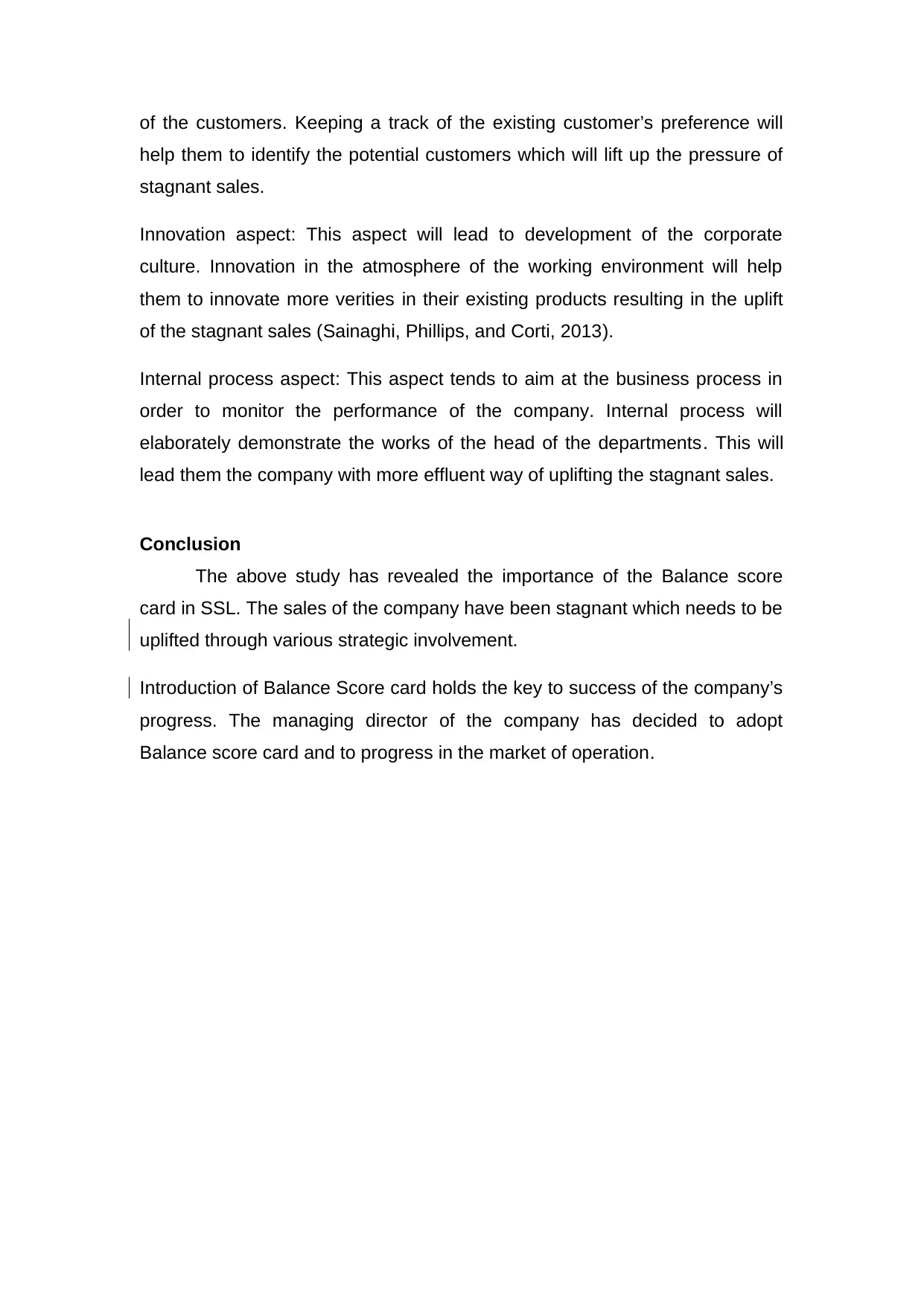
of the customers. Keeping a track of the existing customer’s preference will
help them to identify the potential customers which will lift up the pressure of
stagnant sales.
Innovation aspect: This aspect will lead to development of the corporate
culture. Innovation in the atmosphere of the working environment will help
them to innovate more verities in their existing products resulting in the uplift
of the stagnant sales (Sainaghi, Phillips, and Corti, 2013).
Internal process aspect: This aspect tends to aim at the business process in
order to monitor the performance of the company. Internal process will
elaborately demonstrate the works of the head of the departments. This will
lead them the company with more effluent way of uplifting the stagnant sales.
Conclusion
The above study has revealed the importance of the Balance score
card in SSL. The sales of the company have been stagnant which needs to be
uplifted through various strategic involvement.
Introduction of Balance Score card holds the key to success of the company’s
progress. The managing director of the company has decided to adopt
Balance score card and to progress in the market of operation.
help them to identify the potential customers which will lift up the pressure of
stagnant sales.
Innovation aspect: This aspect will lead to development of the corporate
culture. Innovation in the atmosphere of the working environment will help
them to innovate more verities in their existing products resulting in the uplift
of the stagnant sales (Sainaghi, Phillips, and Corti, 2013).
Internal process aspect: This aspect tends to aim at the business process in
order to monitor the performance of the company. Internal process will
elaborately demonstrate the works of the head of the departments. This will
lead them the company with more effluent way of uplifting the stagnant sales.
Conclusion
The above study has revealed the importance of the Balance score
card in SSL. The sales of the company have been stagnant which needs to be
uplifted through various strategic involvement.
Introduction of Balance Score card holds the key to success of the company’s
progress. The managing director of the company has decided to adopt
Balance score card and to progress in the market of operation.
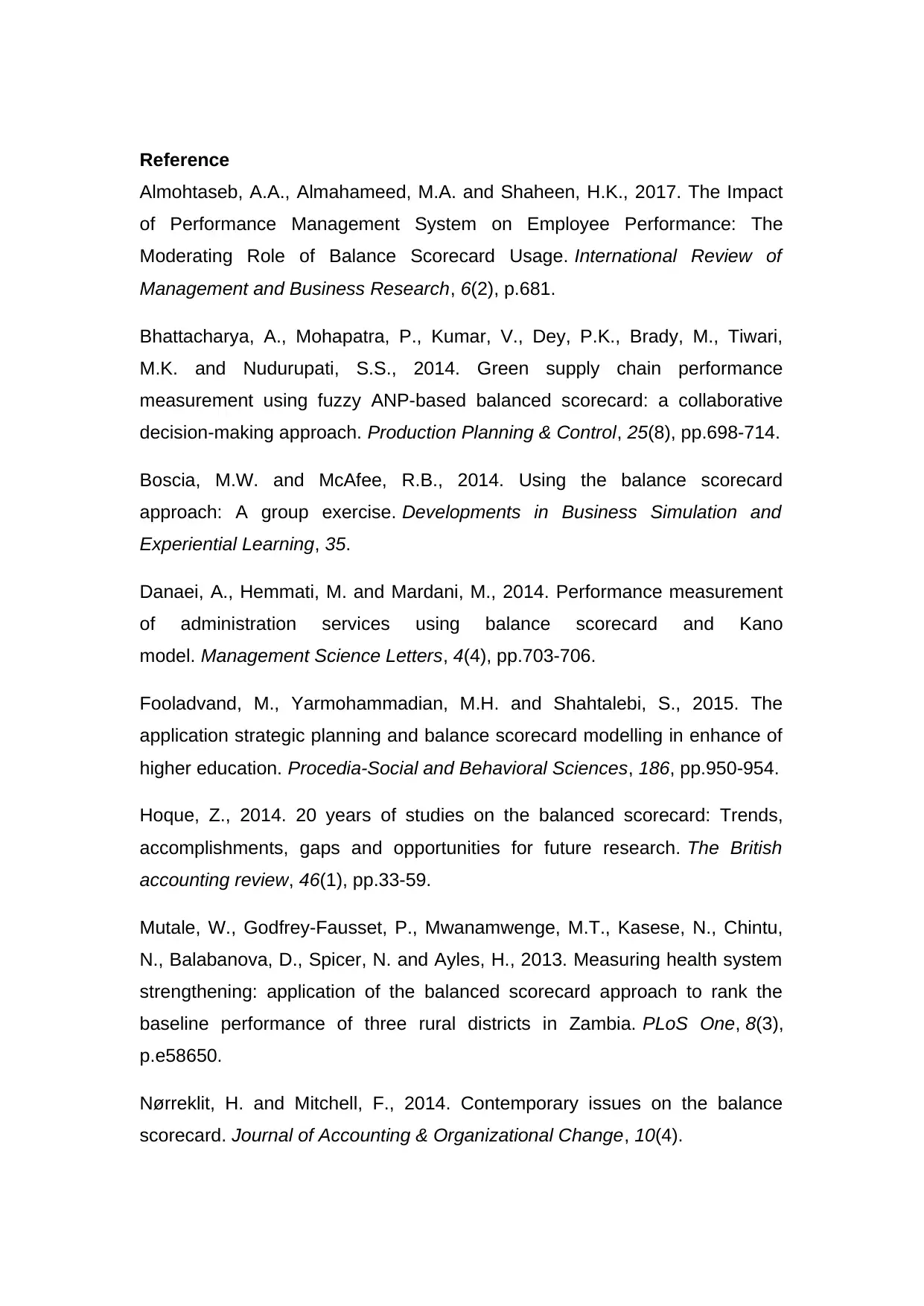
Reference
Almohtaseb, A.A., Almahameed, M.A. and Shaheen, H.K., 2017. The Impact
of Performance Management System on Employee Performance: The
Moderating Role of Balance Scorecard Usage. International Review of
Management and Business Research, 6(2), p.681.
Bhattacharya, A., Mohapatra, P., Kumar, V., Dey, P.K., Brady, M., Tiwari,
M.K. and Nudurupati, S.S., 2014. Green supply chain performance
measurement using fuzzy ANP-based balanced scorecard: a collaborative
decision-making approach. Production Planning & Control, 25(8), pp.698-714.
Boscia, M.W. and McAfee, R.B., 2014. Using the balance scorecard
approach: A group exercise. Developments in Business Simulation and
Experiential Learning, 35.
Danaei, A., Hemmati, M. and Mardani, M., 2014. Performance measurement
of administration services using balance scorecard and Kano
model. Management Science Letters, 4(4), pp.703-706.
Fooladvand, M., Yarmohammadian, M.H. and Shahtalebi, S., 2015. The
application strategic planning and balance scorecard modelling in enhance of
higher education. Procedia-Social and Behavioral Sciences, 186, pp.950-954.
Hoque, Z., 2014. 20 years of studies on the balanced scorecard: Trends,
accomplishments, gaps and opportunities for future research. The British
accounting review, 46(1), pp.33-59.
Mutale, W., Godfrey-Fausset, P., Mwanamwenge, M.T., Kasese, N., Chintu,
N., Balabanova, D., Spicer, N. and Ayles, H., 2013. Measuring health system
strengthening: application of the balanced scorecard approach to rank the
baseline performance of three rural districts in Zambia. PLoS One, 8(3),
p.e58650.
Nørreklit, H. and Mitchell, F., 2014. Contemporary issues on the balance
scorecard. Journal of Accounting & Organizational Change, 10(4).
Almohtaseb, A.A., Almahameed, M.A. and Shaheen, H.K., 2017. The Impact
of Performance Management System on Employee Performance: The
Moderating Role of Balance Scorecard Usage. International Review of
Management and Business Research, 6(2), p.681.
Bhattacharya, A., Mohapatra, P., Kumar, V., Dey, P.K., Brady, M., Tiwari,
M.K. and Nudurupati, S.S., 2014. Green supply chain performance
measurement using fuzzy ANP-based balanced scorecard: a collaborative
decision-making approach. Production Planning & Control, 25(8), pp.698-714.
Boscia, M.W. and McAfee, R.B., 2014. Using the balance scorecard
approach: A group exercise. Developments in Business Simulation and
Experiential Learning, 35.
Danaei, A., Hemmati, M. and Mardani, M., 2014. Performance measurement
of administration services using balance scorecard and Kano
model. Management Science Letters, 4(4), pp.703-706.
Fooladvand, M., Yarmohammadian, M.H. and Shahtalebi, S., 2015. The
application strategic planning and balance scorecard modelling in enhance of
higher education. Procedia-Social and Behavioral Sciences, 186, pp.950-954.
Hoque, Z., 2014. 20 years of studies on the balanced scorecard: Trends,
accomplishments, gaps and opportunities for future research. The British
accounting review, 46(1), pp.33-59.
Mutale, W., Godfrey-Fausset, P., Mwanamwenge, M.T., Kasese, N., Chintu,
N., Balabanova, D., Spicer, N. and Ayles, H., 2013. Measuring health system
strengthening: application of the balanced scorecard approach to rank the
baseline performance of three rural districts in Zambia. PLoS One, 8(3),
p.e58650.
Nørreklit, H. and Mitchell, F., 2014. Contemporary issues on the balance
scorecard. Journal of Accounting & Organizational Change, 10(4).
⊘ This is a preview!⊘
Do you want full access?
Subscribe today to unlock all pages.

Trusted by 1+ million students worldwide
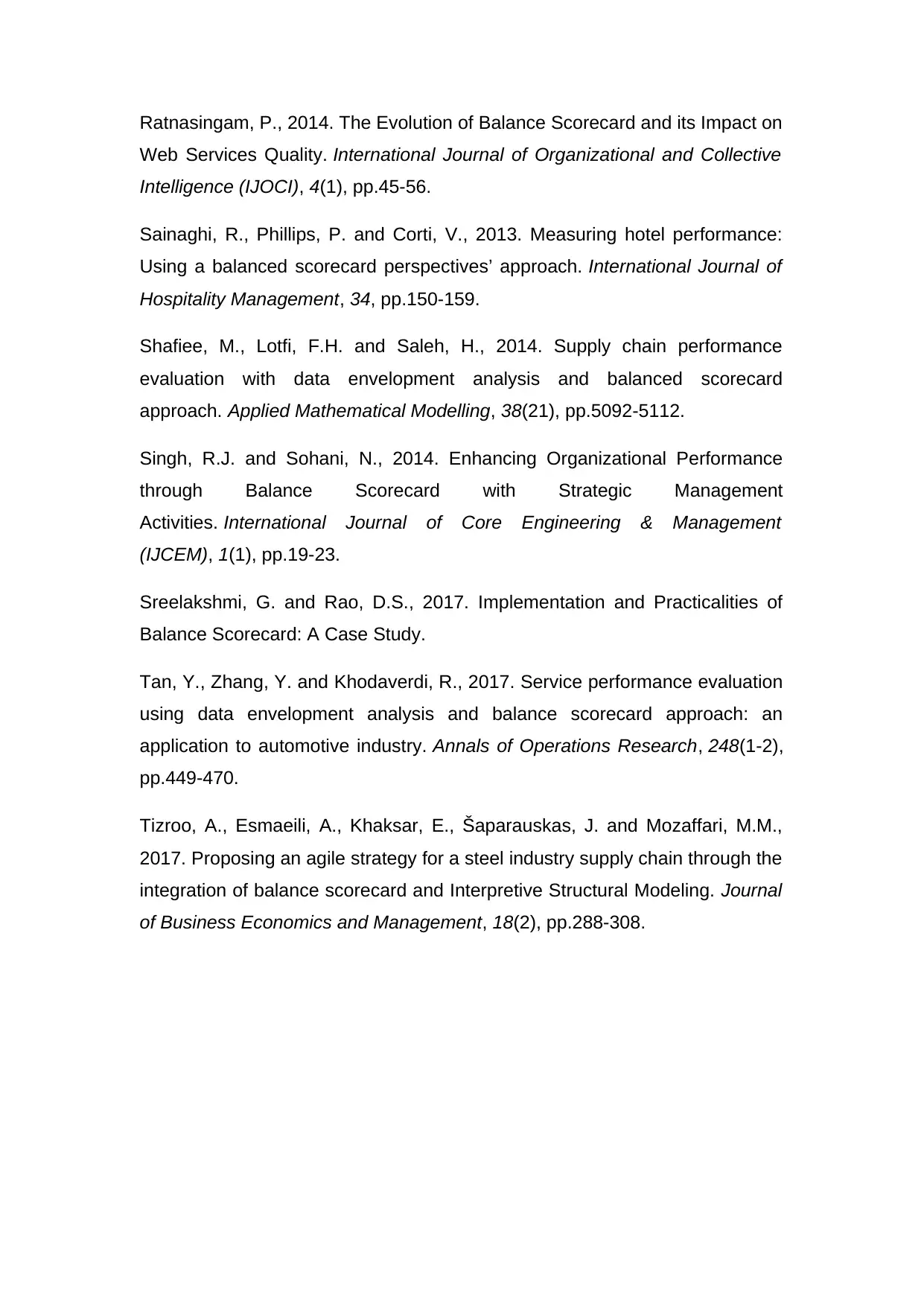
Ratnasingam, P., 2014. The Evolution of Balance Scorecard and its Impact on
Web Services Quality. International Journal of Organizational and Collective
Intelligence (IJOCI), 4(1), pp.45-56.
Sainaghi, R., Phillips, P. and Corti, V., 2013. Measuring hotel performance:
Using a balanced scorecard perspectives’ approach. International Journal of
Hospitality Management, 34, pp.150-159.
Shafiee, M., Lotfi, F.H. and Saleh, H., 2014. Supply chain performance
evaluation with data envelopment analysis and balanced scorecard
approach. Applied Mathematical Modelling, 38(21), pp.5092-5112.
Singh, R.J. and Sohani, N., 2014. Enhancing Organizational Performance
through Balance Scorecard with Strategic Management
Activities. International Journal of Core Engineering & Management
(IJCEM), 1(1), pp.19-23.
Sreelakshmi, G. and Rao, D.S., 2017. Implementation and Practicalities of
Balance Scorecard: A Case Study.
Tan, Y., Zhang, Y. and Khodaverdi, R., 2017. Service performance evaluation
using data envelopment analysis and balance scorecard approach: an
application to automotive industry. Annals of Operations Research, 248(1-2),
pp.449-470.
Tizroo, A., Esmaeili, A., Khaksar, E., Šaparauskas, J. and Mozaffari, M.M.,
2017. Proposing an agile strategy for a steel industry supply chain through the
integration of balance scorecard and Interpretive Structural Modeling. Journal
of Business Economics and Management, 18(2), pp.288-308.
Web Services Quality. International Journal of Organizational and Collective
Intelligence (IJOCI), 4(1), pp.45-56.
Sainaghi, R., Phillips, P. and Corti, V., 2013. Measuring hotel performance:
Using a balanced scorecard perspectives’ approach. International Journal of
Hospitality Management, 34, pp.150-159.
Shafiee, M., Lotfi, F.H. and Saleh, H., 2014. Supply chain performance
evaluation with data envelopment analysis and balanced scorecard
approach. Applied Mathematical Modelling, 38(21), pp.5092-5112.
Singh, R.J. and Sohani, N., 2014. Enhancing Organizational Performance
through Balance Scorecard with Strategic Management
Activities. International Journal of Core Engineering & Management
(IJCEM), 1(1), pp.19-23.
Sreelakshmi, G. and Rao, D.S., 2017. Implementation and Practicalities of
Balance Scorecard: A Case Study.
Tan, Y., Zhang, Y. and Khodaverdi, R., 2017. Service performance evaluation
using data envelopment analysis and balance scorecard approach: an
application to automotive industry. Annals of Operations Research, 248(1-2),
pp.449-470.
Tizroo, A., Esmaeili, A., Khaksar, E., Šaparauskas, J. and Mozaffari, M.M.,
2017. Proposing an agile strategy for a steel industry supply chain through the
integration of balance scorecard and Interpretive Structural Modeling. Journal
of Business Economics and Management, 18(2), pp.288-308.
1 out of 7
Related Documents
Your All-in-One AI-Powered Toolkit for Academic Success.
+13062052269
info@desklib.com
Available 24*7 on WhatsApp / Email
![[object Object]](/_next/static/media/star-bottom.7253800d.svg)
Unlock your academic potential
Copyright © 2020–2025 A2Z Services. All Rights Reserved. Developed and managed by ZUCOL.




